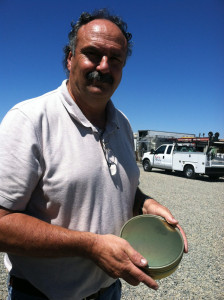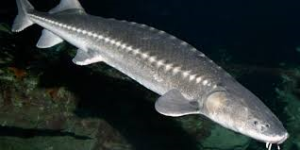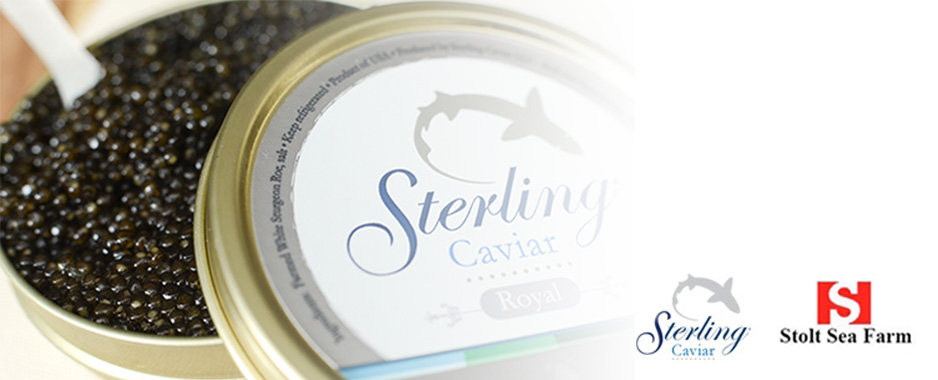By Candace Lampe Taylor
 On a blazing June afternoon, Peter Struffenegger, general manager of Sterling Caviar, steps inside the cool, damp and dimly lit metal building that houses 13 ground-level tanks, each holding 75,000 gallons of warm, re-circulating water and hundreds of adult white sturgeon.
On a blazing June afternoon, Peter Struffenegger, general manager of Sterling Caviar, steps inside the cool, damp and dimly lit metal building that houses 13 ground-level tanks, each holding 75,000 gallons of warm, re-circulating water and hundreds of adult white sturgeon.
Several fins break the surface as a school of 70-pound, 6 year olds lazily glide around one of the fresh-water tanks that separate the fish by sex and weight at this fish aquaculture farm.
Aquaculture is the farming of aquatic critters such as fish, shellfish, and even plants, both land-based and ocean-production.
From tiny “Frys” to mature adults, the white sturgeon are spawned, raised and eventually processed for caviar and meat at Sterling Caviar, which is recognized as an international leader in fish aquaculture.
Virtually unchanged after 250 million years, sturgeons are relics of another age.
“Dinosaurs, really,” reflects Struffenegger. “They’re a fascinating fish…biologically somewhere between an amphibian and a shark. We are still studying them.”
Dinosaurs or not, the sturgeon’s eggs or “roe,” when cleaned, salted and placed into tins as caviar, retail for upward of $5,000 per 1.8 kilograms.
Farm-Raised White Sturgeon
Eerily similar in appearance to a shark, white sturgeon sport gray-green skin instead of scales, a white belly and large, opaque eyes. More than 30 years of trial and error has led Sterling to successfully continue the life cycle of this mysterious fish in an artificial environment.
“This isn’t a get rich quick business. White sturgeon can take up to ten years to raise,” states Struffenegger who joined Sterling in 1986.
He would know— Struffenegger has raised oysters, trout, catfish and salmon. He holds a BA in Aquatic Biology from UCSB and a BS in Fisheries Biology from Humboldt State University.
Farm-raised sturgeon operations were spawned out of economic necessity: Three decades ago, caviar was primarily harvested from the Caspian and Black Sea. Because of over-fishing, economic sanctions, and the rampant poaching of sturgeon, the wild caviar trade has been wiped out. Stepping in to fill the void is farm-raised sturgeon from aquaculture farms like Sterling.
Where in the World is Elverta?
On the surface, Sterling’s facilities appear to reside in the unlikeliest of places.
Sandwiched between two rice farms and a narrow levee road, they operate out of a gaggle of nondescript gray metal buildings on the north edge of Elverta, a tiny hamlet in an unincorporated part of Sacramento County.
The question begs: Why is an international business that caters to the likes of 5-star chefs and millionaires located here? “Because of the perfect trifecta,” Struffenegger explains. “Access to UC Davis and their research, the nearby Sacramento River and well water with a specific temperature.”
What local inhabitants don’t realize is that this 25-year-old business’ combined caviar and sturgeon meat sales yield about $8 million in annual revenue. Sterling Caviar is owned by Stolt Sea Farm and Sierra Aquafarms. Sterling also employs several local residents.
Overall, that’s a pretty good haul for this low-profile company acknowledged worldwide for its superior quality caviar and sturgeon meat. “Nobody else raises white sturgeon in the United States,” Struffenegger states.
Fork it Over
 You won’t find a side order of gold, brown or black caviar to go with your buttermilk pancakes at the Creekside Diner’s menu in nearby Rio Linda. Fact is, the locals don’t crave the pricey delicacy and would be more inclined to use caviar as fish bait if they found a tin of the stuff lying by the side of the road.
You won’t find a side order of gold, brown or black caviar to go with your buttermilk pancakes at the Creekside Diner’s menu in nearby Rio Linda. Fact is, the locals don’t crave the pricey delicacy and would be more inclined to use caviar as fish bait if they found a tin of the stuff lying by the side of the road.
On the flip side, Sterling’s caviar is regularly served in upscale restaurants and delis and sold to discerning caterers. The demand remains strong in certain circles, both nationally and internationally.
Last year, Sterling processed more than 22,000 pounds (or 10 metric tons) of caviar and is raising about 1 million pounds of fish for processing. “We ship a lot of the meat to New York and Boston,” Struffenegger says.
As the whole “farm to fork” craze explodes, residents are taking a fresh look at products and produce that play an integral part in their community’s economic success. Sterling Caviar, right here in Elverta, is poised to ride the wave of sustainable aquaculture farming because of its expertise, longevity and dedicated, knowledgeable staff like Peter Struffenegger.
About the author: Candace is a freelance writer who focuses on the people, places and things that make Rio Linda and Elverta unique. She is also a Real Estate Broker specializing in our community. You can contact her at 916-747-4426 or by email at candacetaylor1960@yahoo.com
White Sturgeon Factoids
DID YOU KNOW? White sturgeons are the largest freshwater fish in North America and can weigh over 1,500 pounds, be 20 feet in length and live for over 100 years. (Side note: Struffenegger revealed that the largest white sturgeon on record weighed 1,800 pounds. It was caught on the Snake River, Idaho)
 SCIENTIFIC NAME: Acipenser transmontanus; acipenser is an old world name meaning sturgeon and transmontanus meaning beyond the mountains.
SCIENTIFIC NAME: Acipenser transmontanus; acipenser is an old world name meaning sturgeon and transmontanus meaning beyond the mountains.
COMMON NAMES: Sacramento sturgeon, Pacific sturgeon, Oregon sturgeon and Columbia sturgeon
DESCRIPTION: Like the green sturgeon the white sturgeon is a primitive, bottom-dwelling fish. It is characterized by its large body size, large head and mouth and long cylindrical body. It has four barbels located in front of its large, wide and toothless mouth, located on the bottom (ventral) side of its head. It has no scales, but “scutes” along its body for protection. Scutes are actually large modified scales that serve as a type of armor or protection. White sturgeon have 11-14 scutes in front of their single dorsal fin, no scutes behind the dorsal, 38-48 scutes on the side, and 9-12 bottom (ventral) scutes. Dorsal color is dark to light gray, pale olive or gray-brown. The white sturgeon’s ventral or bottom surface is white. The scutes are lighter than the body in color, and the fins are dusky to opaque gray.
LIFECYCLE: The white sturgeon is a slow-growing, late-maturing anadromous fish. White sturgeon spawn in large rivers in the spring and summer months and remain in fresh water while young. Older juveniles and adults are commonly found in rivers, estuaries, and marine environments.
Source: US Fish & Wildlife














